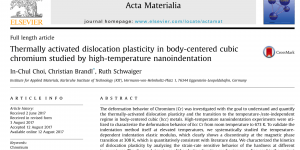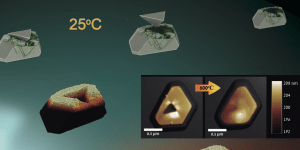cbrandl
PhD / dr. sc. École Polytechnique Fédérale de Lausanne EPFL (Switzerland) Dipl.-Ing. Karlsruhe Institute of Technology (Germany) My research focuses on predictive atomistic simulation approaches to enable rational materials design. With his expertise on defects (e.g. dislocations, interfaces) in materials, he investigates defect-dominated properties (i.e.; strength, reliability, stability) in advanced engineering materials: ranging from metallic nanomaterials (i.e. nanocrystalline metals, nanoparticle, nanolaminates, nanowires), to refractory metals/high entropy alloys.
-
Thermally activated dislocation plasticity in body-centered cubic chromium studied by high-temperature nanoindentation
http://www.sciencedirect.com/science/article/pii/S1359645417306808 The deformation behavior of Chromium (Cr) was investigated with the goal to understand and quantify the thermally-activated dislocation plasticity and the transition to the temperature-/rate-independent regime in body-centered cubic (bcc) metals. High-temperature nanoindentation experiments were utilized to characterize the deformation behavior of bcc Cr from room temperature to 673 K. To validate the indentation method itself at elevated temperatures, we systematically […] -
Self-Healing and Shape Memory Effects in Gold Microparticles through the Defects-Mediated Diffusion
https://onlinelibrary.wiley.com/doi/10.1002/advs.201700159 Abstract: Some metal alloys subjected to irreversible plastic deformation can repair the inflicted damage and/or recover their original shape upon heating. The conventional shape memory effect in metallic alloys relies on collective, or “military” phase transformations. This work demonstrates a new and fundamentally different type of self-healing and shape memory in single crystalline faceted […] -
Interaction of interstitial solid-solution impurities and dislocation motion in body-centred cubic metals
Principal Investigators: Christian Brandl The development of novel materials for high-temperature applications also entails the knowledge of 1) the fundamental mechanisms responsible for materials mechanical behaviour and 2) how does the materials composition modify these mechanisms. The motion of these dislocations and the mutual interaction of dislocations amongst themselves and with impurities govern the macroscopic […]
Number of posts found: 13


